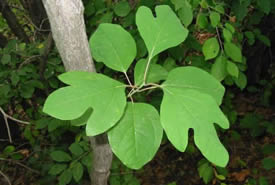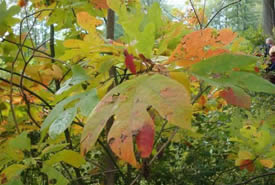Sassafrass

Sassafras (Photo by Bronwen Smith)
Though sassafras trees can grow up to 30 metres in height, they are most often found as a small tree growing along trails, forest edges or in early successional fields.
A pioneer species
The sassafras tree is known as a pioneer species — it is an early colonizer of disturbed sites such as abandoned farm fields or clear cuts. The roots of the sassafras send up new shoots of growth, forming thickets.

Sassafras (Photo by NCC)
Commercial uses
Sassafras wood is commonly used for interior finishes, boats, posts and furniture. It is weak and soft, and durable even when exposed to moisture.
First Nations people used sassafras wood for dugout canoes because of its durability; they also used this tree for a wide variety of medicinal and culinary purposes.
Early European explorers and settlers learned to distill essential oils from the sassafras, which were used as a fragrance in perfumes, soaps and food (sassafras tea and candy flavouring). The oil was also used as a painkiller and an antiseptic in dentistry. In 1976, however, the active ingredient, safrole, was discovered to be a mild carcinogen.
Supported by the Weston Family Foundation.




